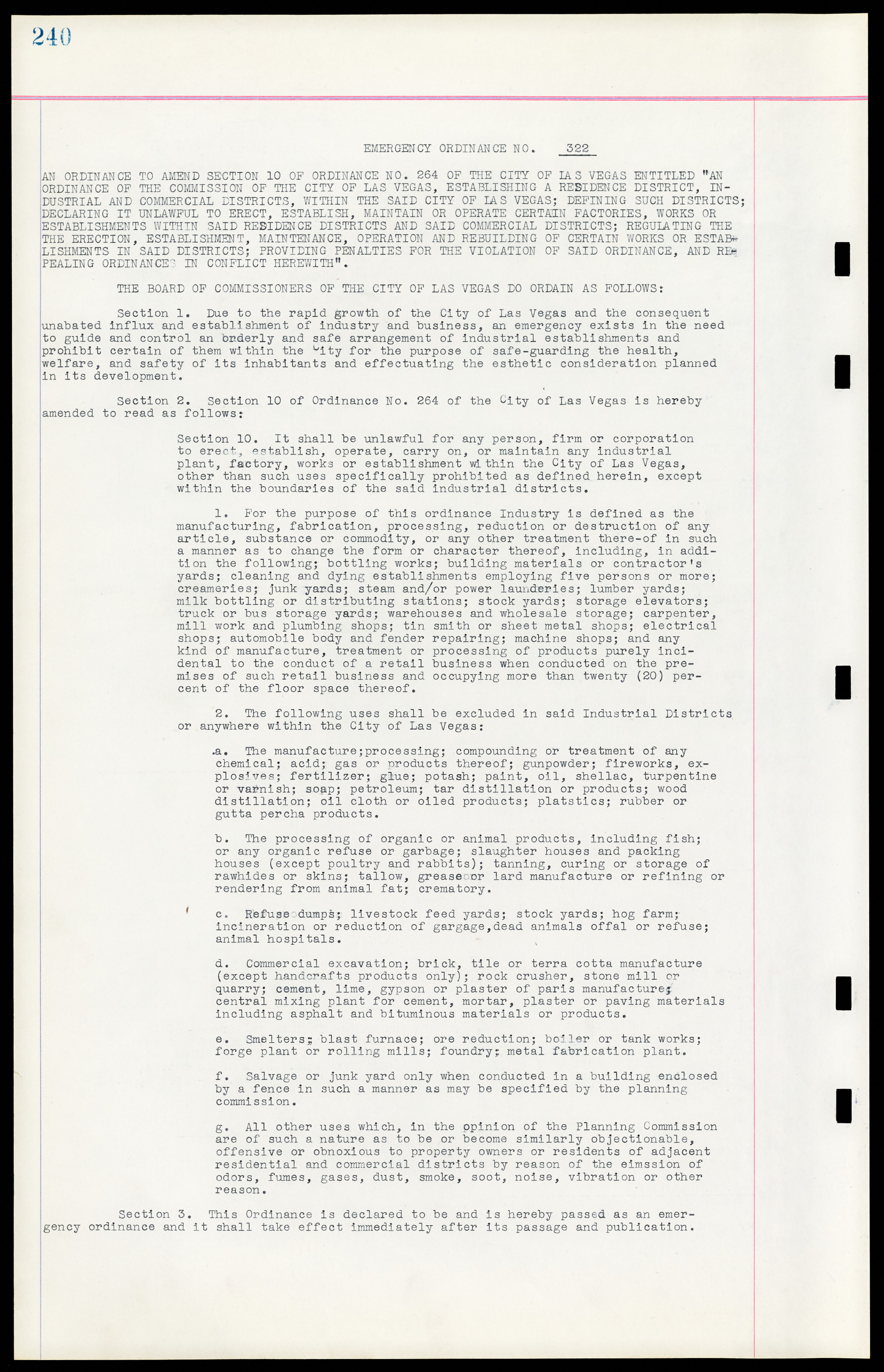Copyright & Fair-use Agreement
UNLV Special Collections provides copies of materials to facilitate private study, scholarship, or research. Material not in the public domain may be used according to fair use of copyrighted materials as defined by copyright law. Please cite us.
Please note that UNLV may not own the copyright to these materials and cannot provide permission to publish or distribute materials when UNLV is not the copyright holder. The user is solely responsible for determining the copyright status of materials and obtaining permission to use material from the copyright holder and for determining whether any permissions relating to any other rights are necessary for the intended use, and for obtaining all required permissions beyond that allowed by fair use.
Read more about our reproduction and use policy.
I agree.Information
Digital ID
Permalink
Details
More Info
Rights
Digital Provenance
Publisher
Transcription
EMERGENCY ORDINANCE NO. 322 AN ORDINANCE TO AMEND SECTION 10 OF ORDINANCE NO. 264 OF THE CITY OF IAS VEGAS ENTITLED "AN ORDINANCE OF THE COMMISSION OF THE CITY OF LAS VEGAS, ESTABLISHING A RESIDENCE DISTRICT, INDUSTRIAL AND COMMERCIAL DISTRICTS, WITHIN THE SAID CITY OF LAS VEGAS; DEFINING SUCH DISTRICTS; DECLARING IT UNLAWFUL TO ERECT, ESTABLISH, MAINTAIN OR OPERATE CERTAIN FACTORIES, WORKS OR ESTABLISHMENTS WITHIN SAID RESIDENCE DISTRICTS AND SAID COMMERCIAL DISTRICTS; REGULATING THE THE ERECTION, ESTABLISHMENT, MAINTENANCE, OPERATION AND REBUILDING OF CERTAIN WORKS OR ESTAB- LISHMENTS IN SAID DISTRICTS; PROVIDING PENALTIES FOR THE VIOLATION OF SAID ORDINANCE, AND RE- PEALING ORDINANCES IN CONFLICT HEREWITH". THE BOARD OF COMMISSIONERS OF THE CITY OF LAS VEGAS DO ORDAIN AS FOLLOWS: Section 1. Due to the rapid growth of the City of Las Vegas and the consequent unabated influx and establishment of industry and business, an emergency exists in the need to guide and control an orderly and safe arrangement of industrial establishments and prohibit certain of them within the City for the purpose of safe-guarding the health, welfare, and safety of its inhabitants and effectuating the esthetic consideration planned in its development. Section 2. Section 10 of Ordinance No. 264 of the City of Las Vegas is hereby amended to read as follows: Section 10. It shall be unlawful for any person, firm or corporation to erect, establish, operate, carry on, or maintain any industrial plant, factory, works or establishment within the City of Las Vegas, other than such uses specifically prohibited as defined herein, except within the boundaries of the said industrial districts. 1. For the purpose of this ordinance Industry is defined as the manufacturing, fabrication, processing, reduction or destruction of any article, substance or commodity, or any other treatment there-of in such a manner as to change the form or character thereof, including, in addition the following; bottling works; building materials or contractor's yards; cleaning and dying establishments employing five persons or more; creameries; junk yards; steam and/or power laundries; lumber yards; milk bottling or distributing stations; stock yards; storage elevators; truck or bus storage yards; warehouses and wholesale storage; carpenter, mill work and plumbing shops; tin smith or sheet metal shops; electrical shops; automobile body and fender repairing; machine shops; and any kind of manufacture, treatment or processing of products purely incidental to the conduct of a retail business when conducted on the premises of such retail business and occupying more than twenty (20) percent of the floor space thereof. 2. The following uses shall be excluded in said Industrial Districts or anywhere within the City of Las Vegas? a. The manufacture; processing; compounding or treatment of any chemical; acid; gas or products thereof; gunpowder; fireworks, explosives; fertilizer; glue; potash; paint, oil, shellac, turpentine or varnish; soap; petroleum; tar distillation or products; wood distillation; oil cloth or oiled products; plastics; rubber or gutta percha products. b. The processing of organic or animal products, including fish; or any organic refuse or garbage; slaughter houses and packing houses (except poultry and rabbits); tanning, curing or storage of rawhides or skins; tallow, grease or lard manufacture or refining or rendering from animal fat; crematory. c. Refuse dumps; livestock feed yards; stock yards; hog farm; incineration or reduction of garbage, dead animals offal or refuse; animal hospitals. d. Commercial excavation; brick, tile or terra cotta manufacture (except handcrafts products only); rock crusher, stone mill or quarry; cement, lime, gypson or plaster of paris manufacture; central mixing plant for cement, mortar, plaster or paving materials including asphalt and bituminous materials or products. e. Smelters; blast furnace; ore reduction; boiler or tank works; forge plant or rolling mills; foundry; metal fabrication plant. f. Salvage or junk yard only when conducted in a building enclosed by a fence in such a manner as may be specified by the planning commission. g. All other uses which, in the opinion of the Planning Commission are of such a nature as to be or become similarly objectionable, offensive or obnoxious to property owners or residents of adjacent residential and commercial districts by reason of the emission of odors, fumes, gases, dust, smoke, soot, noise, vibration or other reason. Section 3. This Ordinance is declared to be and is hereby passed as an emergency ordinance and it shall take effect immediately after its passage and publication.

